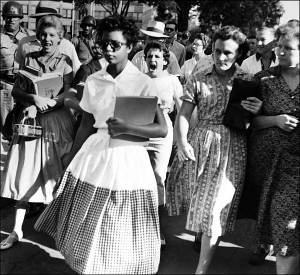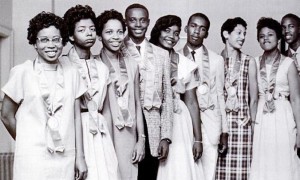It’s back to school time! What are your memories of your first day at a new school? We moved around a lot when I was a kid so I had my first day at a new school three different times. Each time was a little scary, but I did have one thing going for me: the National Guard wasn’t involved.
Sadly, the same can’t be said for the Arkansas high school students who in 1957 came to be known as The Little Rock Nine. Tonight, as you celebrate (or mourn) the fact that summer is over, fall is coming, and school is back in session, raise a glass to this brave group of kids. After all, all they really wanted to do was just go to school.
In 1954, the Supreme Court declared segregation illegal in Brown vs. The Board of Education. Almost immediately after the decision, many southern chapters of the NAACP started trying to enroll black students in all-white schools. It would be almost a full year later before the Superintendent of Schools in Little Rock, Arkansas submitted his plan for gradual integration, and I do mean gradual: the plan wouldn’t be implemented for another two years. Nevertheless, it was a plan, and two years later on September 4, 1957, nine black students walked through the doors of Little Rock Central High School for the first time. Or, they tried to at least.
Several segregationist groups in the area had openly threatened to protest and physically block the students from entering the school. Because of these threats, Arkansas Governor Orval Faubus did the only sensible thing he could think of: he deployed the National Guard.
To support the segregationists.
Seriously.
Orval felt this “forced” integration would cause a lot of violence, so he decided to call in the National Guard to prevent the students from entering the building.
Oh Orval.
The next day, President Eisenhower called Orval and was like, “Orval! Ever hear of the Supreme Court? Don’t be an asshole. Do your job.” Orval put his fingers in his ears and said, “la la la.”
So Eisenhower, probably while rubbing the bridge of his nose and sighing heavily, federalized the National Guard and reversed Orval’s orders.
But Orval wasn’t done. He retaliated by closing all public schools in the city for an entire school year. For real. Arkansas calls it “The Lost Year.” Look it up. It’s ridiculous.
But enough about Orval. I’ve already written the word “Orval” way more than I ever imagined I’d have to. Let’s talk about these kids instead. Let’s talk about The Little Rock Nine:
- Minnijean Brown
- Elizabeth Eckford
- Ernest Green
- Thelma Mothershed
- Melba Patillo
- Gloria Ray
- Terrence Roberts
- Jefferson Thomas
- Carlotta Walls
The Little Rock chapter of the NAACP knew these kids would need to be special. Excellent grades and exemplary attendance were a given, but there was more. Any person, much less a teenager, thrown into a situation this hostile would need to display a certain level of undefinable grace, an inner strength and determination that would equip them to face the inevitable hate and anger they would encounter.
In the weeks leading up to the first day of school, the NAACP had chosen 39 kids to register. These kids were then directed to take part in a series of intensive counseling sessions designed to give them a sense of what to expect, and how to respond to hostile situations. By the time the first day of school rolled around, only nine remained.
Can you imagine? Put yourself in that situation if you can. You’re in high school, you’ve been selected to become one of the first black kids in America to attend a previously all-white high school. Did they have any idea of what was to come? Were they aware of their place in history? And while I’m sure the NAACP did their best to counsel these kids, nothing could have prepared them for what came next. Just listen to a few of these stories.
- Melba Patillo had acid thrown in her eyes.
- A few months later, a group of girls trapped her in a bathroom stall and tried to set her on fire.
- Gloria Ray was pushed down a flight of stairs.
- Minnijean Brown was being taunted by a group of guys in the cafeteria so she dropped a hot bowl of chili on them. Awesome, right? Way to stick up for yourself! So what happened to her? She was suspended for six days.
- Later in the year, a girl threw a purse filled with combination locks at Brown’s head. So she called her “white trash.” Again, awesome! So what happened to her? She was expelled. What happened to the girl that threw the purse? I don’t know, ticker tape parade, probably.
The stories go on, but the students braved it all. And at the end of the school year, Ernest Green (he was the only senior in the group) became the first black student in history to graduate from Little Rock Central High School. Dr. Martin Luther King Jr. attended the ceremony.
Green, by the way, went on to serve as Assistant Secretary of the Federal Department of Labor under President Carter. Minnijean Brown worked as Deputy Assistant Secretary for Work Force Diversity in the Department of the Interior under President Clinton. Patillo worked as a reporter for NBC and wrote a book about her experiences called “Warriors Don’t Cry.” Terrence Roberts and Carlotta Walls also wrote books about their experiences.
Amazing stuff.
So raise a glass tonight to these nine brave, beautiful black students from Little Rock. These are heroes. These are names we should know. These are the people we should talk about when we talk about courage under fire.



